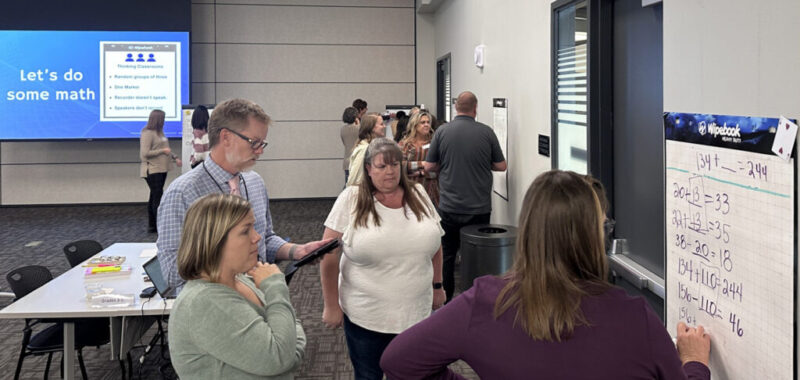
Riverside County teachers collaboratively learn with the Riverside County Office of Education math team around increasing student thinking.
Credit: Riverside County Office of Education
At the Riverside County Office of Education, we serve about 430,000 students across 23 districts, providing instructional support and other direct services in all content areas. In recent years, our state math assessment data has indicated a need for improvement in how our students learn math. As a state and county, we have struggled to show the hoped-for growth in math in our statewide Smarter Balanced Assessments.
We don’t believe that recommending all our districts adopt new textbooks or curricula would solve the problem because we’d still be teaching math the same way. Instead, we decided to align to evidence-based practices to change our math culture countywide.
This is how we, in collaboration with our districts, are working toward a better math learning experience for our students.
Our renewed focus on math culture aligns with national organizations like the National Council of Teachers of Mathematics and the National Council of Supervisors of Mathematics. The work we are doing also aligns very well with the California’s newly revised math framework. A few of the goals of focusing on culture are to increase student access, build positive identity and develop agency within students. These align directly with the ideas in chapters 1 and 2 of the new framework. Our approach to the teaching and learning of mathematics, informed by national reports such as “Adding It Up” and instructional models like cognitively guided instruction (CGI) honors what students bring to the classroom and builds on it while focusing on a balance between procedural skills, conceptual understanding and application.
Due to numerous factors, mathematics instruction tends to spend a great deal of time on skills and procedures such as adding, subtracting, multiplying and dividing for the purpose of getting answers. There is a continued focus on procedural skills in elementary mathematics. But, instead of drilling students on these processes over and over, we could be spending time helping them understand the mathematics behind the processes by encouraging them to share their thinking.
We’ve also seen an interplay between math culture improvements and equity. Changing people’s hearts and minds opens doors to more equitable access for students because educators start to recognize that there aren’t low, medium and high students. Rather, there are students who have had diverse opportunities to learn math, and we should listen to them about what they know and how they learn.
Ultimately, this culture shift is about student engagement. If students in a classroom are tuned out, we can choose to continue with the status quo, or we can help them see the beauty in math and how it connects to their lives and the things they care about.
Much of our work is additionally grounded in the Teaching for Robust Understanding framework, the book “Street Data” by Shane Safir and Jamila Dugan, and the Universal Design for Learning framework. These ideas underpin the three major aspects of our service: direct contract work with districts, countywide professional development, and the District Math Collaborative.
We introduce ideas about math culture reform in our professional development contract work with districts. Districts reach out to us when they’d like to do customized professional development work to improve math teaching and learning.
The District Math Collaborative began with seven districts in spring 2022, and we have continued to grow. Collaboration has centered around reflecting on teaching and learning systems, how they affect students, and how to continuously improve them.
In addition, we have our annual Week of Math. This event is designed to allow educators, students and families to experience math differently — to find joy in mathematics. We partner with MIND Education to provide many of the games, stories and experiences through their MathMINDs program. We chose this program because it encourages the exploration, problem-solving and pattern-seeking that is the foundation of mathematics instruction we’d like to see in our classrooms. Students and their families delight in solving problems together, which builds community and reinforces the notion that everyone can be a “math person.”
The anecdotal feedback has been great. We’ve visited schools to measure implementation and conduct surveys on how students perceive the changes. In classrooms with high implementation, we hear that students are more engaged, and that students who were labeled as low or struggling with low participation are now talking and engaging in meaningful ways.
One of the schools that took the early initiative to work with us about five years ago — Quail Valley Elementary in Menifee Union School District — has exceeded state, county and district averages on assessments for the last two years in the grade levels with high implementation. We make sure to let all our districts know about this sort of success, because an important characteristic of culture is that it’s shared by a whole community.
Our advice to anyone seeking to improve math culture is to find people who are energized by your ideas and lift them up. In time, they’ll lift others up as well.
•••
Dennis Regus, Karon Akins, Diana Ceja and Susan Jagger are the mathematics administrators from Riverside County Office of Education in California.
The opinions in this commentary are those of the authors. If you would like to submit a commentary, please review our guidelines and contact us.

